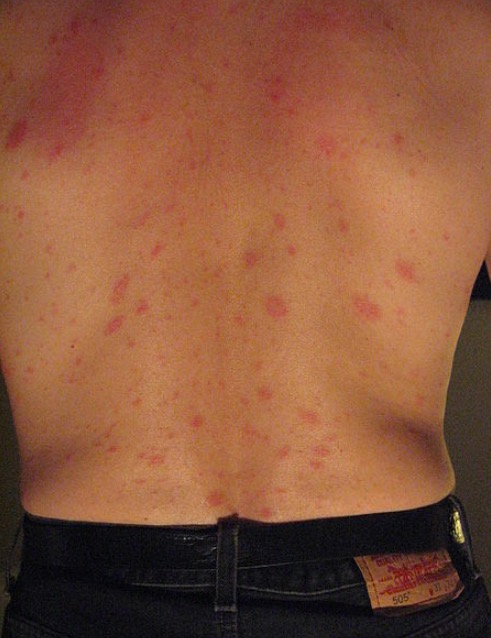Playlist
Show Playlist
Hide Playlist
Generalized Rashes: Nummular Eczema, Pityriasis Rosea and Psoriasis
-
Slides GeneralizedRash AcuteCare.pdf
-
Download Lecture Overview
00:01 Okay. 00:02 Let's move on to nummular eczema. 00:03 And this one I include just because it can look like a few different types of rash, but it is its own form of illness. 00:13 And what you look for is these two or even larger, up to 10 cm erythematous plaques, they have a sharp border and they have some scale. 00:22 So, taken out of context, they might look like a tinea, like a fungal infection, but they – with that sharp border and with a scale. 00:33 However, they are a lot more widespread than most fungal infections. 00:37 They also have a certain distribution, dorsal hands and feet, extensor surfaces of the limbs. 00:42 And treatment, like a lot of forms of eczema, is moisturizers and topical corticosteroids. 00:47 Because this one is more widespread, it can be difficult to use topical corticosteroids, and so, therefore, you may need to think about sending these cases on to dermatology for further management. 01:00 Pityriasis rosea can seem very scary. 01:03 I think patients who get it are very, very concerned because it is such a broad generalized rash, but it actually is benign. 01:12 So, here, you're looking for, again, fairly big lesions, these salmon-colored patches, they usually have a distinct border as well. 01:20 Things to look for are herald patch. 01:22 And you can see one in the picture on the left. 01:25 It's just a larger lesion. 01:26 It’s the herald patch. 01:28 So, it heralds the rashes to come. 01:30 So, therefore, it appears first. 01:33 It's usually a little bit bigger. 01:35 And even when I see patients two or three days later, it still stands out. 01:38 It’s like there's the patch that started it all. 01:40 A lot of times, because this rash is common on the trunk, if you look at the patient from the front or from the back, you’ll actually see kind of a Christmas tree pattern to the rash and that it kind of looks like it's a little bit more in the middle and then kind of more diffused on the sides. 02:01 And I think that usually it's a pretty benign rash. 02:05 Sometimes it does follow viral illness. 02:08 There's not much to do because the pruritus associated with is pretty mild. 02:12 You can give some antihistamines or something along those lines if it's really bothering patients a lot because this one is so widespread. 02:19 Creams don't work very well. 02:21 But usually, it’s just a question of reassuring the patient. 02:26 All right. Now, something that's, obviously, more prolonged and more serious is psoriasis. 02:31 And psoriasis affects about 2% of US adults. 02:34 Most have the plaque form. 02:36 You’re going to look at the extensor surfaces. 02:38 The classics are knees and elbows. 02:41 This is not your knee. 02:42 I know this. 02:46 In terms of management, just to really briefly summarize psoriasis management because it has changed a lot. 02:52 This is to me not the majority of patients I see, but when the skin involvement is pretty minimal, less than 5%, just treat topically and treat intermittently. 03:03 And patients with more severe psoriasis, where even though it’s only a small area and corticosteroids aren’t effective, I do refer on to dermatology. 03:12 You can consider the calcineurin inhibitors again for more continuous treatment, which avoids the side effects of the topical corticosteroids. 03:21 In my mind and in my practice, though, most patients have a more extensive involvement of their skin or they have evidence of arthritis. 03:30 This is a skin disorder with a large component of promoting other types of symptoms as well, the main one being arthritis. 03:40 And now, the current management is to really think about using early disease modification in these patients to avoid particularly chronic joint disease as well as improve quality of life with skin lesions. 03:55 So, with that, I think we've covered our rashes and we are going to be moving on. 04:00 Thank you for your attention.
About the Lecture
The lecture Generalized Rashes: Nummular Eczema, Pityriasis Rosea and Psoriasis by Charles Vega, MD is from the course Acute Care. It contains the following chapters:
- Nummular Eczema
- Pityriasis Rosea
- Psoriasis
Included Quiz Questions
A 40-year-old woman presents with oval lesions in crops on the trunk and proximal areas of the extremities. The long axes of these oval lesions are mostly oriented along the lines of cleavage of the skin. She reports a single oval rash about 3 cm on her back 10 days ago. Which of the following is the most appropriate pharmacotherapy?
- No pharmacotherapy is required at this time.
- Topical steroids
- Topical antifungal
- Topical emollients
- Topical calcineurin inhibitors
Which of the following is the typical anatomical distribution of nummular eczema?
- Legs and the upper extremities
- Flexor surfaces
- Trunk
- Face
- Neck
Which of the following is the most appropriate pharmacotherapy for intertrigo?
- Moisture reduction and topical antifungal
- Moisturization and topical steroids
- Moisturization and topical antifungal
- Moisture reduction and topical steroids
- Reassurance and oral antihistamine
Customer reviews
5,0 of 5 stars
| 5 Stars |
|
2 |
| 4 Stars |
|
0 |
| 3 Stars |
|
0 |
| 2 Stars |
|
0 |
| 1 Star |
|
0 |
I liked his joke! He's really knowledge and own clinical sense of epidemiology, presentation, etc. are inspiring!
Rashes are very common in the outpatient setting, I've seen a lot in the urgent care. Thank you very much for summarizing, all that information.






